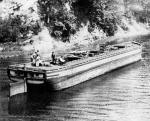![header=[Marker Text] body=[This anthracite coal transportation facility helped fuel America's Industrial Revolution in the 19th century. It was vital to the shipment of up to one-half million tons of coal annually along the Schuylkill Canal to Philadelphia and throughout the region. Also known as Palo Alto Loading Dock, it was built by the Schuylkill Navigation Company on land held by stockholder and Philadelphia merchant Thomas Firth. ] sign](http://explorepahistory.com/kora/files/1/10/1-A-E7-139-ExplorePAHistory-a0a4t8-a_450.gif)
Mouse over for marker text
Name:
Firth Dock
Region:
Valleys of the Susquehanna
County:
Schuylkill
Marker Location:
Route 209 between Pottsville and Port Carbon
Dedication Date:
October 23, 1999
Behind the Marker
The  Schuylkill Canal ran from the Firth Dock at Port Carbon along a southeastern route to Port Clinton and then due south through the bustling industrial towns of Reading, Pottstown, and Norristown, before ultimately reaching the city of Philadelphia by way of Manayunk. The 108-mile canal route included both man-made waterways and improved sections of the Schuylkill River. Firth Dock was the last of five loading docks built by the Schuylkill Navigation Company (SNC) in Schuylkill County. Thomas Firth gave permission to the SNC to build the dock on his property. Notably, Firth was an official and stockholder in the company.
Schuylkill Canal ran from the Firth Dock at Port Carbon along a southeastern route to Port Clinton and then due south through the bustling industrial towns of Reading, Pottstown, and Norristown, before ultimately reaching the city of Philadelphia by way of Manayunk. The 108-mile canal route included both man-made waterways and improved sections of the Schuylkill River. Firth Dock was the last of five loading docks built by the Schuylkill Navigation Company (SNC) in Schuylkill County. Thomas Firth gave permission to the SNC to build the dock on his property. Notably, Firth was an official and stockholder in the company.
Firth Dock was an engineering marvel built by Scottish civil engineer, George Duncan. In 1828, when the dock was first constructed, animal drawn carts unloaded coal into awaiting boats from the dock's stone walls a few feet above water level. It was enlarged in 1845-46 to receive cargo from steam locomotives. Track lay on both sides of the dock's 900-foot length. Elevated 18 feet above the waterline, it was able to load 30 boats of 180-ton burden at the same time. Firth Dock shipped coal continuously from 1828 until its closure in 1871.
Continuing on down the canal, flat boats loaded with coal were towed by horses or mules. The average speed was no more than two or three miles per hour and, of course, nothing moved during winter months if the canal water froze. These limitations, coupled with the labor-intensive nature of canal transport, conspired to limit the canal era to little more than three decades.
By the 1850s, railroads had replaced canals as the primary mode of commercial transportation. The Schuylkill Canal was representative of this story. Although in the late 1830s, one of the best investments in America was stock in the Schuylkill Navigation Company (dividends averaged 15 percent to 19 percent annually), the company steadily lost business after the Civil War era. The system was purchased by the Philadelphia and Reading Railroad Company in 1870. The P&R continued limited operations of the canal until the 1930s.
Firth Dock was an engineering marvel built by Scottish civil engineer, George Duncan. In 1828, when the dock was first constructed, animal drawn carts unloaded coal into awaiting boats from the dock's stone walls a few feet above water level. It was enlarged in 1845-46 to receive cargo from steam locomotives. Track lay on both sides of the dock's 900-foot length. Elevated 18 feet above the waterline, it was able to load 30 boats of 180-ton burden at the same time. Firth Dock shipped coal continuously from 1828 until its closure in 1871.
Continuing on down the canal, flat boats loaded with coal were towed by horses or mules. The average speed was no more than two or three miles per hour and, of course, nothing moved during winter months if the canal water froze. These limitations, coupled with the labor-intensive nature of canal transport, conspired to limit the canal era to little more than three decades.
By the 1850s, railroads had replaced canals as the primary mode of commercial transportation. The Schuylkill Canal was representative of this story. Although in the late 1830s, one of the best investments in America was stock in the Schuylkill Navigation Company (dividends averaged 15 percent to 19 percent annually), the company steadily lost business after the Civil War era. The system was purchased by the Philadelphia and Reading Railroad Company in 1870. The P&R continued limited operations of the canal until the 1930s.





